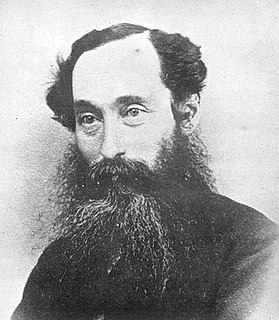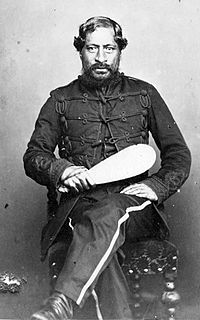
Sir Edward William Stafford served as the third premier of New Zealand on three occasions in the mid 19th century. His total time in office is the longest of any leader without a political party. He is described as pragmatic, logical, and clear-sighted.

Christchurch Girls' High School in Christchurch, New Zealand, was established in 1877 and is the second oldest girls-only secondary school in the country, after Otago Girls' High School.

The healthcare system of New Zealand has undergone significant changes throughout the past several decades. From an essentially fully public system based on the Social Security Act 1938, reforms have introduced market and health insurance elements primarily since the 1980s, creating a mixed public-private system for delivering healthcare.

Mete Kīngi Te Rangi Paetahi was a Member of Parliament in New Zealand. He was one of four Māori elected in the first Māori elections of 1868 for the new Māori electorates in the House of Representatives.
The Third Atkinson Ministry was a responsible government in New Zealand, sometimes referred to as part of the Continuous Ministry. It took office after the retirement of Frederick Whitaker and continued the personnel and policies of the Whitaker and Hall ministries.
Japanese New Zealanders are New Zealand citizens of Japanese ancestry, which may include Japanese immigrants and descendants born in New Zealand. Japanese people first began immigrating to New Zealand in the 1890s. Until 1920, 14 Japanese citizens resided in New Zealand. Japanese immigration was halted during the period of the Pacific War and recommenced around the 1950s. From this period onwards, Japanese immigration remained small until the 1990s. In 1997, Japanese peoples were the 19th-largest ethnic group in New Zealand. As of the 2018 census, 18,141 New Zealand residents identify themselves as Japanese New Zealanders.
The First Stafford Ministry was the third responsible government to be formed in New Zealand, and the first to last more than a few weeks. It formed in June 1856, and lasted until July 1861. As the office of Premier had yet to be established, Edward Stafford served as head of the government, although initially Henry Sewell was the Minister who reported to the Governor.

Housing in New Zealand was traditionally based on the quarter-acre block, detached suburban home, but many historical exceptions and alternative modern trends exist. New Zealand has largely followed international designs. From the time of organised European colonisation in the mid-19th century there has been a general chronological development in the types of homes built in New Zealand, and examples of each generation are still commonly occupied.

Mental health in New Zealand generally follows the trends of mental health in other OECD countries. New Zealand's 'outdoor life style' and high standard of living are balanced by isolation and a self-reliant culture, which discourages asking for help. Historically, people with mental health problems were institutionalised, whereas now the focus is on care in the wider community. The stigma around poor mental health has been lessened in recent years as a result of this change and public education campaigns. However, New Zealand's minorities and youth continue to be over-represented in the negative mental health statistics.

The cartography of New Zealand is the history of surveying and creation of maps of New Zealand. Surveying in New Zealand began with the arrival of Abel Tasman in the mid 17th century. Cartography and surveying have developed in incremental steps since that time till the integration of New Zealand into a global system based on GPS and the New Zealand Geodetic Datum 2000.
The Second Fox Ministry was a responsible government which held power in New Zealand from July 1861 to August 1862. Although William Fox was the head of the government, he was never appointed Premier as that office had yet to be established. Instead, he was Attorney-General and then Colonial Secretary.
The Whitaker-Fox Ministry was a responsible government which held power in New Zealand from October 1863 to November 1864. Although Frederick Whitaker was the head of the government, he was never appointed Premier as that office had yet to be established. Instead, he was Attorney-General sitting in the Legislative Council while William Fox led the Government in the lower house.
The Third Fox Ministry was a responsible government which held power in New Zealand from June 1869 to September 1872. Although William Fox was the head of the government, he was never appointed Premier as that office had yet to be established, although he did resign the office at the end of his tenure. The Ministry was also known as the Fox-Vogel Ministry as most of the agenda was set by the Treasurer, while Fox busied himself with administrative affairs and moral crusades such as the attempted introduction of local option polls for liquor licensing.
The Third Stafford Ministry was the tenth responsible government to be formed in New Zealand, and lasted for a month.
The Fourth Fox Ministry was a responsible government which held power in New Zealand from March to April 1873.
The First Vogel Ministry was a responsible government which held power in New Zealand from April 1873 to July 1875.
The Second Vogel Ministry was a responsible government which held power in New Zealand from February to September 1876.
The Fourth Atkinson Ministry was a responsible government in New Zealand, which lasted less than a week. It formed on 28 August 1884 after the fall of the first attempt at a Stout-Vogel coalition and lasted until Robert Stout and Sir Julius Vogel took back their majority on 3 September.
The Second Stafford Ministry was the eighth responsible government to be formed in New Zealand, and one of the longer-lasting ministries during this period. It formed in October 1865 and lasted until June 1869. However, it was defeated in a vote of confidence on 15 August 1866 and resigned, to be reconstituted with three ministers replaced, so some contemporaries regarded it as two separate Ministries. As the office of Premier had yet to be formally established, Edward Stafford did not carry this title officially.














